Ocean Freight Education Material
New Version
1. Export Shipping Instructions
When an exporter engages a custom broker or forwarder to handle the customs declaration, he/she must give instructions on what to do with the shipment in the shipping instructions. The format of the shipping instructions varies, but all the forms essentially contain the same information. One form is often used in different modes of transportation.
The exporter may provide the BLAI to the customs broker after he/she has obtained a shipping order (S/O) or a space booking number from the carrier. The BLAI usually is provided to the customs broker before obtaining the S/O in cases where the packing list and valid export permit are required to obtain the S/O.
The BLAI normally is accompanied by a copy of the commercial invoice and packing list, and the Insurance Application-Instructions if the customs broker is to arrange for insurance.
Some exporters supply
the original L/C or its photocopy without supplying the BLAI, and let the
forwarder manage the rest of the export routines with payment of fees and
charges, which may include preparing of export documents and sending them to
the bank.
Sample Form:
B/L Application-Instructions
--- Export Shipping Instructions
|
|||||||||||||||||||||||||||||
|
|||||||||||||||||||||||||||||
| ¡@ | ¡@ | ||||||||||||||||||||||||||||
| ¡@ | A. | The CLEAN "ON BOARD" bill of lading is required. | |||||||||||||||||||||||||||
| B. | The short form (blank back) bill of lading is: | ||||||||||||||||||||||||||||
| C. | The transport documents issued by the freight forwarder are: | ||||||||||||||||||||||||||||
| D. | The charter party bill of lading is: | ||||||||||||||||||||||||||||
| 1. | SHIPPER/CONSIGNOR | ||||||||||||||||||||||||||||
| 2. | CONSIGNEE | ||||||||||||||||||||||||||||
| 3. | NOTIFY PARTY | ||||||||||||||||||||||||||||
| 4. | ALSO NOTIFY | ||||||||||||||||||||||||||||
| 5. | CARRIER - VOYAGE/FLIGHT NO. | ||||||||||||||||||||||||||||
| 6. | LOADING ON BOARD DATE | ||||||||||||||||||||||||||||
| 7. | DISPATCH/TAKING IN CHARGE DATE | ||||||||||||||||||||||||||||
| 8. | FROM (Port of Loading) | ||||||||||||||||||||||||||||
| 9. | |||||||||||||||||||||||||||||
| 10. | TO (Port of Discharge) | ||||||||||||||||||||||||||||
| 11. | VIA (Tranship At) | ||||||||||||||||||||||||||||
| 12. |
THENCE TO (For Transhipment To) | ||||||||||||||||||||||||||||
| 13. | DESCRIPTION OF PACKAGES & GOODS: | ||||||||||||||||||||||||||||
| 14. | MARKS & NUMBERS: | ||||||||||||||||||||||||||||
| 15. | BILL OF LADING MARKED: | ||||||||||||||||||||||||||||
|
|||||||||||||||||||||||||||||
| Issued by: | Date: | ||||||||||||||||||||||||||||
The dock receipt---shipping note---when signed by the receiving clerk (cargo checker) at the container terminal or dock is a proof of the delivery of goods.
Please see the sample Dock Receipt below. The format of the dock receipt varies, but the contents are basically the same. Some dock receipts may include the Commodity Code (of goods) field. In practice, the commodity code of goods may be entered in the "Description of Packages and Goods" field in the dock receipt.
The dock receipt is made out by the customs broker following the instructions and information contained in the shipping order (S/O), B/L application-instructions (BLAI or the export shipping instructions) and packing list.
The number of copies of the dock receipt required depends on the circumstances. Certain countries require a fixed number, where at least one signed copy is returned to the forwarding agent or the shipper as proof of delivery. The bill of lading (B/L) is issued in due course in exchange for the dock receipt.
The bill of lading (B/L) is made out word for word according to the dock receipt. Therefore, it is very important that the shipper provides the correct information in the B/L application-instructions and packing list, and that the customs broker or forwarder does not make any errors and omissions in the dock receipt, otherwise a discrepancy may occur in the B/L and the bank will reject the documents.
The phrase "only clean dock receipt accepted" in the dock receipt is to ensure that the receiving clerk (cargo checker) at the container terminal or dock puts a 'clean' or similar notation on the conditions of goods received.
The dock receipt can be clean or foul (unclean, dirty or claused). If a dock receipt is clean, the bill of lading (B/L) issued in due course will be clean, otherwise the B/L will be foul (please refer to the Clean versus Foul Bills of Lading for more information).
Sample Form:
Dock Receipt
(Shipping Note)
|
|||||||||||||
| |
|||||||||||||
The bill of lading (in ocean transport), waybill or consignment note (in air, road, rail or sea transport), and receipt (in postal or courier delivery) are collectively known as the transport documents.
Please see the sample Ocean Bill of Lading below. The bill of lading (B/L) serves as a receipt for goods, an evidence of the contract of carriage, and a document of title to the goods. The carrier issues the B/L according to the information in a dock receipt, or in some cases according to a completed working copy of the B/L supplied by the customs broker.
The B/L must indicate that the goods have been loaded on board or shipped on a named vessel, and it must be signed or authenticated by the carrier or the master, or the agent on behalf of the carrier or the master. The signature or authentication must be identified as carrier or master, and in the case of agent signing or authenticating, the name and capacity of the carrier or the master on whose behalf such agent signs or authenticates must be indicated.
Unless otherwise stipulated in the letter of credit (L/C), a bill of lading containing an indication that it is subject to a charter party and/or that the vessel is propelled by sail only is not acceptable.
In cases where the B/L
does not have pre-printed wording indicating that the goods have been loaded
on board or shipped on a named vessel, the loading on board a named vessel
is evidenced by the on board notation (e.g. "on board",
"laden on board" or "shipped on board") on the B/L,
which must be initialled and dated by the carrier or its agent. The date of
the on board notation is considered to be the date of shipment.
The number of original bills of lading (Bs/L) may be expressed as 3/3 (read as 'three of three') or 2/2 (read as 'two of two'). In the sample Letter of Credit the L/C stipulates "Full set 3/3 ...", which means that DEF Imports requires a full set B/L containing three originals.
If the L/C did not contain the expression "Full set 3/3", then the number of original bills of lading required would depend on the number as so issued by the carrier. It can be a sole original B/L, that is, one original only.
The originals are marked as "original" on their face and all have equal value, that is, all have the same validity. The purpose of issuing more than one original is to ensure that the port of destination will receive the original when dispatched separately. The original Bs/L are proof of ownership of goods, one of which must be surrendered to the carrier at destination, duly endorsed by the title holder in the goods in exchange for the goods or the delivery order. When one of the originals being surrendered to the carrier, the others become invalid.
¡@The copies of the B/L can be of any number. The number depends on the requirements of the importer, importing country, shipper, carrier, Chamber of Commerce (if the L/C calls for certification of the B/L), and Consulate (if the L/C calls for consular legalization of the B/L).
In the sample Letter
of Credit DEF Imports requires two copies of the non-negotiable copy of
bill of lading.
Under the shipper's load and count arrangement, the shipper or its agent must seal the container before transferring it to the carrier. The container that originates from a bonded factory outside the EPZ (export processing zone) or from a factory inside the EPZ is sealed before leaving the bonded factory or the EPZ.
The metal seal for the
container is provided by the carrier. The seal number is entered on the dock
receipt and the B/L. If a seal is broken for customs purposes, a customs
inspector must supervise the breaking of the seal and the resealing of the
container. The new seal number replaces the previous number that was entered
on the dock receipt.
The notify party depends on the L/C requirement, it can be the importer, freight forwarder or bank. In the sample Letter of Credit the L/C stipulated "notify the above accountee", in other words the notify party is DEF Imports, 7 Sunshine Street, Sunlight City, Import-Country.
If the notify party and the consignee are the same party, then enter the word "SAME" or "CONSIGNEE" in the 'Notify Party' field in the bill of lading (B/L).
Sample Document:
Ocean Bill of Lading
Remarks: Fields
or items in blue color contain links to the
explanation.
|
||||||||||||||||||||||||||||||||||
( SEE REVERSE FOR TERMS AND CONDITIONS ) |
||||||||||||||||||||||||||||||||||
4.
Letter of Credit (Documentary Credit)
--- Opens by means of airmail
The sample letter of credit (L/C) below is a comprehensive case study of a Confirmed Irrevocable Letter of Credit opens by means of airmail.
For the explanations of the
stipulations and fields in the L/C, please see Letter
of Credit Particulars and Export
Documentary Requirements. And, please consult the table of contents in
different departments (Export, Shipping, Production, etc.) for other topics and
discussions.
|
||||||||||||||||||||||||||||||||||||||||||||||||||||||||||||||||||||||||||||||||||||||||||||||||||||||||||||||||||||||||||||||||||||||||||||||||||||||||||||||||
Sample
Document: The sample letter of credit (L/C)
below is a comprehensive case study of a Confirmed
Irrevocable Letter of Credit opens by means of full
text cable (in SWIFT format). For the explanations of the
stipulations and fields in the L/C (i.e., under the Message Text in the L/C),
please see Letter
of Credit Particulars and Export
Documentary Requirements. And, please consult the table of contents in
different departments (Export, Shipping, Production, etc.) for other topics and
discussions.
Letter of Credit (Documentary Credit)
--- Opens by means of full text cable (in SWIFT
format)
|
||||||||||||||||||||||||||||||||||||||||||||||||||||||||||||||||||||||||||||||||||||||||||||||||||||||||||||||||||||||||||||||
SWIFT stands for Society for Worldwide Interbank Financial Telecommunications
The documentary credit---letter
of credit, documentary letter of credit, or commercial
letter of
against stipulated document(s), provided that the terms and conditions of the documentary credit are fully complied with.
For purpose of maintaining
uniformity in the text, the words "letter of credit", "credit"
and "
Please see the sample letter of credit.
Irrevocable versus Revocable Letters of
Credit
A letter of credit (L/C) can be irrevocable or revocable. The L/C usually indicates whether it is an irrevocable or revocable letter of credit. In the absence of such indication, the L/C is deemed to be irrevocable.
In some cases, an irrevocable L/C received by the beneficiary may become invalid without the amendment or cancellation of such L/C, for example, when the trade between importing and exporting countries is suspended such as in a trade sanction, or when the issuing bank has ceased operation.
There have been cases of an irrevocable L/C being amended without the consent of the beneficiary in the OEM arrangements. The beneficiaries affected were export-manufacturers from a developing country. The importers were able to convince and instruct the issuing bank to amend the latest date for shipment in the L/C, changing to a date earlier than the agreed upon date, at which time the beneficiary would not be able to ship the OEM products. The importers used sneaky tactics that aimed to cause the beneficiaries to default in the delivery. The intention of the importers was to cancel the orders from the existing OEM suppliers and buy from other suppliers in another developing country where the prices had become lower.
In the event of an amendment like the above-mentioned case, the beneficiary must give notification of rejection of amendment to the bank that advised the amendment at once.
Irrevocable and Without Recourse Letter of Credit
The irrevocable letter of credit
received from an advising bank may be indicated as "irrevocable
and without recourse documentary credit". The words
"without recourse" mean that the advising bank will not be able to
recover the money paid to the beneficiary in case the issuing bank does not
pay the advising bank.
The revocable L/C was not uncommon in the 1970's and earlier when dealing with less developed countries. It is rarely seen these days in international trade.
An exporter whose method of payment is a confirmed irrevocable L/C is assured of payment even if the importer or the issuing bank defaults. The confirmed irrevocable L/C is particularly important from buyers in a country which is economically or politically unstable.
In a confirmed letter of
credit, the exporter or the importer pays an extra charge called the
confirmation fee, which may vary from bank to bank within a country. The fee
usually is added to the exporter's account. The exporter may indicate in the
sales contract that the confirmation fee and other charges outside the
seller's country are on the buyer's account.
Restricted Negotiable versus
Freely Negotiable Letters of Credit
When a letter of credit (L/C) is specifically designated "revolving letter of credit", the amount involved when utilized is reinstated, that is, the amount becomes available again without issuing another L/C and usually under the same terms and conditions.
The revolving L/C may be used in shipments of a wide range of goods to a buyer within a period of time (several months to one year usually).
The format of customs export declaration forms varies from country to country. The form typically contains the information found in the commercial invoice and the bill of lading or waybill. In addition, the form may include:
The exporter normally must sign an authorization paper (the power of attorney) allowing the customs broker or the forwarder to handle the customs declaration.
In certain countries, exporters may prepare the customs declaration forms by themselves and let the customs broker handle the rest of the customs formalities.
¡@
The pattern of cargo
reception and shipment has changed with the use of the freight
In the 1960's, many seaports either had inadequate container facility or none at all. Consequently, export shipments often relied on conventional (break-bulk) vessels. The cargoes were placed alongside a vessel for hoisting on board. The stevedores (longshoremen) were often employed to carry cargoes on and off the vessel. The loading and unloading of vessels consumed too much time, which caused dockside bottlenecks and delayed shipments. With the increased use of containers, the congestion was decentralized. The problem of congestion was transferred from the docks or piers to the container freight stations or terminals.
Containers are available in configurations to take almost every kind of cargo and mode of transportation (ocean, air, road, and rail).
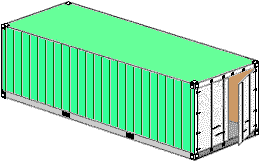 |
|
| Dry Cargo Container | |
(2) Specific
purpose container
It is used to facilitate the packing (loading) and emptying (unloading) of
container other than by means of doors at one side of the container, and for
other specific purposes like ventilation.
![]() Specific Cargo Container
Specific Cargo Container
(1) Thermal container (reefer)
It has insulated walls, doors, roof, and floor, which limit the range of
temperature loss or gain. It is used for perishable goods like meat, fruits
and vegetables.
(2) Tank
container
It is used for the carriage of bulk gases and liquids like chemicals.
(3) Dry bulk
container
It is used for the carriage of dry solids in bulk without packaging, such as
grains and dry chemicals. It consists of a cargo-carrying structure firmly
secured within the intercontinental container framework.
(4) Named
cargo types
It consists of various types of containers, such as automobile (car)
containers and livestock (cattle and poultry) containers.
The unit load device (ULD) is the air equivalent of the ISO container. Due to its unique shape resembling an igloo, the ULD is sometimes called the igloo (or iglu).
The air mode containers mainly are of the IATA (International Air Transport Association) types. The popular sizes of ULD include the IATA Type:
| IATA Type | |||
|
5 |
88" | x 125" | x 64" |
|
3 |
88" | x 125" | x 86" |
Several other types of ULD are also in use worldwide.
Containers intended for intercontinental use have external nominal dimensions of:
¡@| Length | ----- | 9.8125
feet (2.991m) as 10 feet; 19.875 feet (6.058m) as 20 feet; 29.9375 feet (9.125m) as 30 feet; and 40 feet (12.192m) |
| Width | ----- | 8 feet (2.438m) |
| Height | ----- | 8.5
feet (2.591m) and 9.5 feet (2.896m) |
All above dimensions have permissible tolerances.
The 20 feet
(20') and 40 feet (40') containers are very popular in ocean freight. The 8.5
feet (8.5') high
The demand for the high cube container---hicube---is increasing. The popular high cube container has a normal height of 9.5 feet (9.5' or 9' 6").
There are half height containers (4.25' or 4' 3" high) designed for heavy loads such as steel rods and ingots, which absorb the weight limit in half the normal space.
The most
widely used type of container is the general purpose (dry cargo) container
having a nominal length and height of
The container capacity is the total cube a container can accommodate. The term cube often refers to the cubic measurement of cargo. The capacity (i.e., the internal volume) is determined by multiplying the internal dimensions, that is, the product of internal length, width and height. The capacity may vary among containers of the same length and height.
Rating is the
maximum gross mass (or weight), that is, the maximum permissible weight of a
container plus its contents. The rating of a 20' dry cargo container is
24,000 kgs. (52,900 lbs.), and a 40', including the high cube container, is
30,480 kgs. (67,200 lbs.).
Tare Mass---tare weight or tare---is the mass (or weight) of empty container, including all fittings and appliances used in a particular type of container in its normal operating condition.
The tare
mass of containers may vary due to the different construction techniques and
materials used in the container. A 20' x 8.5' dry cargo container may weigh
1,800 kgs. to 2,400 kgs., a 40' x 8.5' may weigh 2,800 kgs. to 4,000 kgs,
and a 40' x 9.5' may weigh 3,900 kgs. to 4,200 kgs. Some dry cargo
containers may fall outside the indicated weight range. The reefer weighs
more than a dry cargo container of the same size.
Payload is the
maximum permitted mass (or weight) of payload, including the dunnage and
cargo securement arrangements that are not associated with the container in
its normal operating condition. Therefore,
If the tare mass of a 20' dry cargo container is 2,400 kgs. and a 40' is 3,900 kgs., the payload of 20' is 21,600 kgs. (i.e., 24,000 kgs. minus 2,400 kgs.) and 40' is 26,580 kgs. (i.e., 30,480 kgs. minus 3,900 kgs.). However, the exporter may be prohibited to have that much payload in areas where there are legal limitations to the overall load of a vehicle.
In exporting, it is common to encounter a payload of 17,500 kgs. or less in the 20' container, and 24,000 kgs. or less in the 40' container.
The rating, tare mass and payload of a container is marked on its wall, usually on the end (rear) door in the case of an end-loading dry cargo container.
Each
container has an identification code or container
The container number is entered on the bill of lading to facilitate the identification and tracking of the container and the cargo.
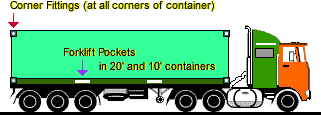
Dimension of General Purpose Containers
| CONTAINER | Capacity | Recommended Load Volume |
|||||
| Nominal Dimension |
Length | Width | Height | Cubic Feet |
Cubic Meter |
Cubic Feet |
Cubic Meter |
| External | 20' | 8' | 8' 6" | ¡@ | ¡@ | ¡@ | |
| 6.096 m | 2.438 m | 2.591 m | |||||
| Internal | 19' 4.25" | 7' 10" | |||||
| 5.899 m | 2.353 m | ||||||
| External | 40' | 8' | 8' 6" | ¡@ | ¡@ | ¡@ | |
| 12.192 m | 2.438 m | 2.591 m | |||||
| Internal | 39' 5.375" | 7' 8.625" | 7' 10" | 2385 cft | 2050 cft | ||
| 12.024 m | 2.353 m | 2.388 m | 67.535 cbm | 58 cbm | |||
| External | 8' | 9' 6" | ¡@ | ¡@ | ¡@ | ||
| 12.192 m | 2.438 m | 2.896 m | |||||
| Internal | 39' 5.375" | 7' 8.625" | 8' 10" | 2690 cft | 2350 cft | ||
| 12.024 m | 2.353 m | 2.692 m | 76.172 cbm | 66 cbm | |||
| NOTE: | Containers with the same external length may not have exactly the same internal length and width. |
| The Recommended Load Volume (RLV) refers to the suggested maximum cube to use in calculating a full container load. The RLV can be about 10-15% less than the container capacity, depending on the export pack dimensions. |
Rear view of 20' x 8.5' container |
CAUTION: Miscalculated capacity may result in a large empty and unusable space or a shortage in space. For example (see 20' x 8.5' container diagram on the left), the master cartons have a uniform height of 20 inches, and the length and width are greater than the height. If 1170 cubic feet is used to calculate a 20' full container load, most likely some cartons will not fit despite the empty space of about 170 cubic feet. You cannot stuff the remaining cartons into the remaining 14" high empty space. |
Containerized
Shipments
The use of containers
in export shipments makes the transport and handling easier and faster. The
crane and gantry are commonly used in handling containers. The forklift is also
used at the docks and container terminals to move the 20' and shorter dry cargo
containers, which are equipped with forklift
pockets---fork pockets or tine pockets. The ports
worldwide handle over 100 million TEUs annually. The unit TEU
(twenty-foot equivalent unit) is used to express the relative number of
containers based on the equivalent length of a 20' container. For example, 100
containers of 20' is 100 TEUs, while 100 containers of 40' is 200 TEUs. The
container ships used in the international traffic are designed with the cells
(compartments with cell guides) resembling a honeycomb wherein the containers
are placed, thus named cellular container ships. The ships
are bigger and faster nowadays, especially those used in the deep-sea voyage
(long haul). Those rated below 20 knots are common in the short-sea voyage
(short haul). The knot is a unit of ship's speed, being one nautical mile per
hour. One nautical mile is 1.852 kilometers. A ship that steams at 20 knots is
moving at a speed of about 37 kilometers per hour. Some
cellular container ships in the 20 to 23 knot range can accommodate 2,000 to
3,000 TEUs. Some rated 24 knots have a carrying capacity of 4,000 to 4,900 TEUs
and load of 56,000 to 75,000 metric tons. The length of the vessel can be about
900' (275 meters) and the The
prefix 'multi-' means at least two or many. The term mode refers to the way
or means. Multimodal transport means at least two different modes of
transportation. In export shipping, it refers to delivery using a
combination of usually ocean and land (rail or road) carriers, and using
only one shipping document known as through bill of lading or combined
transport bill of lading, issued usually by the ocean shipping company or
its agent.
The
metal seal that is provided by the carrier and used in securing the
container doors is tamperproof, but it is easily removed. In some countries,
the importer's customs broker may use padlocks to secure the doors of
container for their client once the FCL (full container load) shipment
reached the destination port.
Multimodal Transport and Transhipment
Container Size, Number and Load Options
The cargo weight and cube influence the size and number of containers needed for an order. The term cube refers to the cubic measurement of cargo.
From the analysis in the Case Sample: Container Selection (1) below, it is obvious that not all 1,500 cartons (2,250 cu. ft. or 63.713 CBM) will fit into two 20' containers or one 40' standard container. A solution is to request the importer to adjust the order to 1,365 cartons (2,047.5 cu. ft or 57.979 CBM) to make one 40' FCL (full container load), in case the high cube container (the hicube) is not available. The alternate solution is to use a 40' hicube. However,
Some of the shipping companies having high cube containers include:
Case Sample: Container Selection (1) An importer
orders 1,500 cartons of product DX. The gross weight of each carton is
10.5 kilograms and its length-width-height is The
cargo gross weight of 15,750 kilograms suits a 20' or a 40' container.
The total cube is The
capacity of a 20' container is about 1,170 cu. ft. (33.131 CBM) and a
40' is about Analysis on some possible methods of stowing product DX and the total number of cartons that will fit into a container, based on the internal dimension of the general purpose container and the Diagram: Package Orientation, is as follows: |
||||||||||||||||||||||||||||||||||||||||||||||||||||||||||||||||||||||||||||||||||||||||||||||||||||||||||||||||||||||||||||||||||||||||||||||||||||||||||||||||||||||||||||||||||||||||||||||||||||||||||||||||||||||||||||||||||||||||||||||||||||||||||||||||||||||
|
||||||||||||||||||||||||||||||||||||||||||||||||||||||||||||||||||||||||||||||||||||||||||||||||||||||||||||||||||||||||||||||||||||||||||||||||||||||||||||||||||||||||||||||||||||||||||||||||||||||||||||||||||||||||||||||||||||||||||||||||||||||||||||||||||||||
|
||||||||||||||||||||||||||||||||||||||||||||||||||||||||||||||||||||||||||||||||||||||||||||||||||||||||||||||||||||||||||||||||||||||||||||||||||||||||||||||||||||||||||||||||||||||||||||||||||||||||||||||||||||||||||||||||||||||||||||||||||||||||||||||||||||||
7.
Packing
(Loading) and Emptying the Containers
The hand packing and emptying of containers is still common in many countries. The time required in packing or emptying a container depends on the kind, size and weight of the cargo, the means (manual or mechanical), and the number of persons doing the packing or emptying. Packing generally takes more time than emptying.
The
unitized load facilitates the loading, unloading and inventory of shipment,
and improves the cargo security against theft, pilferage and damage.
Not all shippers have a container loading dock or raised bank with suitable dock plate at their premises, where the forklift and pallet truck can enter the container. The cargo is often manually or mechanically lifted from the ground onto the container that sits on the chassis (the bogie) or flatbed truck (the open truck). The inclining belt conveyor sometimes is used to move the cargo from the ground up to the container doors, and the roller conveyor is used to convey the cargo from the container doors to the inner section, particularly when packing a 40' container, which is deep.
In case the
shipper's premises have a raised bank and the forklift is used, the forklift
must have a lift mast that is non-rising and less than 7' 6" (i.e., less
than 90 inches), in order to allow cargo to be forked into a standard dry cargo
container.
Inspecting the Container
In the case of a CY/CY or CY/CFS container service, the shipper has to arrange for the drayage of the empty container from the carrier's container terminal to the shipper's premises. The shipper must inspect the container to ensure it will adequately protect the cargo. In a dry cargo container, the doors, walls and ceiling demand the utmost attention.
The doors must be in good working condition and the door locking bars should secure and lock properly. The load may push against the container doors during a rough sea voyage. Even though the rating of a 20' container is 24,000 kgs., the doors cannot withstand that much pressure of solid load pushed against them during conveyance.
The walls and ceiling must be free from cracks or damage to prevent water and moisture from entering. There is a chance that a dry cargo container will be carried on deck since the cellular container ship carries about one-third of the containers on deck. The possible ingress of the sea water, rain and salt-laden moisture through a damaged container may ruin the cargo.
Always
inspect the container before using it. If a container was contaminated (e.g.
chemical spill) in prior use, then using the same container can be hazardous.
Extra caution must be taken when packing food products in a dry cargo container.
Some food products may absorb odor and moisture.
Stowage of Container
Never allow anyone to smoke inside a container. A carelessly discarded cigarette can cause a serious fire that may destroy the cargo and the ship, and may cause the loss of life.
In tropical areas, the air inside a dry cargo container is hot, humid and suffocating, especially inside a 40' container. To relieve discomfort when packing a container, it is necessary to use forced ventilation with an electric blower or fan. The air humidity is high, especially during the wet or rainy season. Forced ventilation can minimize humid air from being trapped inside a container, as the air may condense into liquid and damage the cargo when the container enters a subzero temperature area.
The weight of cargo must be distributed evenly within the container. As a rule of thumb, the center of gravity should not be above half the height of the container, and it should be within two feet from the center of container in the front-rear direction and within one foot in the sidewise (transverse) direction.
Cargoes like video monitors and glass wares have a stacking limit or the maximum stack. Otherwise, the compression from excess weight of overlaying packages may damage the goods underneath. For this reason, heavier packages should never be stowed above lighter packages. Liquids should never be stowed above non-liquids. Keep soft packages away from other packages or objects with protrusions or sharp corners, to prevent damage cause by movement at sea and on land (rail and truck).
A ship at sea may move in different directions simultaneously. Always apply dunnage (i.e., material used to separate and protect the cargo from damage during conveyance, for example, foam, mat and fiberboard) and/or cargo securements when necessary to prevent the cargo from crashing and cascading inside the container. Cascaded cargo may lie against the container doors, posing danger to any person who opens the doors.
The pallet stowing patterns [L], [M] and [N] presented below as viewed from the top of the container:
| Pattern [L] |
 |
| Pattern [M] |
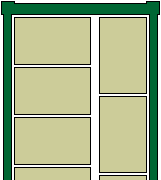 |
| Pattern [N] |
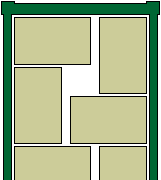 |
| Pallet Orientation | |||
| [2] | Y || W | Z || D | |
LEGEND:
|
|||
| 20' Container | ||||||
| Pallet |
[L] | [L] | [M] | [N] | ||
| Pallet Orientation >> |
[1] | [2] | [1] + [2] | |||
| Total Pallets |
Total Pallets |
Total Pallets |
Total Pallets |
Utilized |
||
| Pallet Size | ¡@ | ¡@ | ¡@ | ¡@ | ||
| Y Side | Z Side | |||||
| 45" | 53" | 5 | 8 | 89.39% | ||
| 45" | 45" | 10 | 10 | 94.87% | ||
| 44" | 52" | 5 | 8 | 85.76% | ||
| 44" | 44" | 10 | 10 | 90.70% | ||
| 41" | 49" | 5 | 8 | 9 | 10 | 94.12% |
| 40" | 48" | 5 | 8 | 9 | 10 | 89.96% |
| 40" | 40" | 10 | 10 | 74.96% | ||
| 36" | 45" | 12 | 10 | 11 | 10 | 91.08% |
| 36" | 36" | 12 | 12 | 72.86% | ||
| 35" | 44" | 12 | 10 | 11 | 10 | 86.58% |
| 34" | 45" | 12 | 10 | 11 | 10 | 86.02% |
| 33" | 44" | 14 | 10 | 12 | 12 | 95.24% |
| 40' Container | ||||||
| Pallet |
[L] | [L] | [M] | [N] | ||
| Pallet Orientation >> |
[1] | [2] | [1] + [2] | |||
| Total Pallets |
Total Pallets |
Total Pallets |
Total Pallets |
Utilized |
||
| Pallet Size | ¡@ | ¡@ | ¡@ | ¡@ | ||
| Y Side | Z Side | |||||
| 45" | 53" | 10 | 16 | 87.69% | ||
| 45" | 45" | 20 | 20 | 93.07% | ||
| 44" | 52" | 10 | 18 | 94.64% | ||
| 44" | 44" | 20 | 20 | 88.98% | ||
| 41" | 49" | 11 | 18 | 20 | 20 | 92.33% |
| 40" | 48" | 11 | 18 | 20 | 20 | 88.24% |
| 40" | 40" | 22 | 22 | 80.89% | ||
| 36" | 45" | 26 | 20 | 23 | 22 | 96.79% |
| 36v | 36" | 26 | 26 | 77.43% | ||
| 35" | 44" | 26 | 20 | 23 | 22 | 92.01% |
| 34" | 45" | 26 | 20 | 23 | 22 | 91.41% |
| 33" | 44" | 28 | 20 | 24 | 24 | 93.43% |
The above indicates the stowing pattern is inapplicable or unnecessary due to the large-sized pallet or pallet with equal sides.
The % Floor Utilized is based on the highest Total Pallets (i.e., the highest total number of pallets in a container for the given pallet size, stowing pattern and pallet orientation).
Referring to the Table: Pallet Yield above, the number of pallets in a container can be doubled by double stacking of pallets, but at the expense of the total height and the gross weight of each loaded pallet. Stack loading is possible only if the cargo underneath can stand up to the compression from the overlaying pallet, and the center of gravity does not exceed half the height of the container.
To prevent the cargo beneath the stack from being torn and damaged, use dunnage like plywood, compressed particle board, fiberboard, and matting, to separate the lower and upper pallets. L-shaped wood or steel corner supports can be used to give added strength to the packages.
To prevent
the pallets from shifting and crushing inside the container, block and brace the
pallets at the voids with lumber and plywood, or secure them with chains, ropes
and straps to the bull rings at the upper and lower corners of the side walls of
the container.
Interlocking of Export Packs
Interlock the export
packs (e.g. cartons or bags) on a pallet and inside a container wherever
possible. Please see the Diagram: Interlocked Cargo below. The interlocked cargo
provides load stability, giving a compact stow that reduces the potential of
collapse with movement on land, air and at sea.
Diagram: Interlocked Cargo
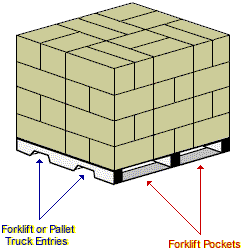 |
|
|
Pallets are built with varied construction techniques. The materials commonly used in the construction of pallets are wood (softwood and hardwood) and plastic (high density polyethylene). Metals (steel and aluminum) are also used but less frequently.
The low cost
softwood pallet---made of softwoods like pine and
The wooden pallet is often customized to suit the type, size and weight of the exporter's cargo and to meet handling and loading requirements.
The plastic pallet generally costs more than a wooden pallet of the same size, but it is chemical and moisture resistant, cleans easily, is lighter, and will not splinter. Hence, the plastic pallet is more durable than the wooden pallet. Nevertheless, the wooden pallet is used most often in export shipments.
![]() Two-Way or Four-Way Pallets
Two-Way or Four-Way Pallets
A two-way pallet allows forking at the two opposite sides of the pallet, while a four-way pallet allows forking at all four sides. The four-way pallet is good for both pallet orientations [1] and [2].
 |
Two-Way Pallet |
 |
Two-Way Pallet |
 |
Four-Way Pallet |
 |
Four-Way Pallet |
![]() Single-Faced or Double-Faced Pallets
Single-Faced or Double-Faced Pallets
A single-faced pallet has one full deck (i.e., non-reversible deck), which is often called a skid, while a double-faced pallet has two full decks (i.e., reversible decks). The double-faced pallet is ideal for stack loading, racking of palletized cargo, and conveyor use.
 |
Single-Faced
Pallet Skid |
 |
Double-Faced Pallet |
![]() With Forklift Pockets or
With Forklift Pockets or
With Forklift or Pallet Truck Entries
Pallets with the
forklift pockets allow forking with a forklift, while pallets with the
forklift or pallet truck entries allow forking with either a forklift or a
pallet truck. Some pallets are designed with forklift pockets that also
permit forking with a pallet truck, in which the rollers beneath the forks
of the pallet truck can come in firm contact with the floor of warehouse and
container.
 |
With Forklift Pockets |
 |
With
Forklift or Pallet Truck Entries |
![]() Two-Way Single-Faced Pallet
Two-Way Single-Faced Pallet
It is usually made
of wood, with forklift or pallet truck entries.
 |
Two-Way Single-Faced Pallet |
![]() Two-Way Double-Faced Pallet
Two-Way Double-Faced Pallet
It is usually made
of wood, with forklift pockets
 |
Two-Way Double-Faced Pallet |
![]() Four-Way Single-Faced Pallet
Four-Way Single-Faced Pallet
It is usually made
of wood or plastic. The four-way single-faced pallet made of wood may have a
'half-deck' at the bottom. The four-way single-faced pallet made of plastic
usually does not have a bottom deck
 |
Four-Way Single-Faced Pallet ('Half-deck' bottom) |
![]() Four-Way Double-Faced Pallet
Four-Way Double-Faced Pallet
It is usually made
of plastic or wood, with forklift pockets at all four sides
 |
Four-Way Double-Faced Pallet |
Besides the full container ship, the RO/RO (roll on/roll off) vessel and the LASH are other systems of water transport used in international trade.
The RO/RO is equipped with ramp(s) that makes loading and unloading from the side and/or bow (front of vessel) and/or stern (rear of vessel) possible. Some modern RO/ROs are designed as a trailer/break-bulk/container carrier suitable for the deep-sea voyage (long haul), making loading and unloading of containers from the top, like a full container ship, possible using the crane. The type of cargo that can be carried on a RO/RO is flexible, including large objects.
The full RO/RO has low stowage factors, as a result of wasted space around the underside of the trailers and other motor vehicles. Therefore, the full RO/RO is not ideal for deep-sea trade. The low stowage factors, however, are compensated for by the quickness of the "turn around' time in ports in the short-sea voyage (short haul).
In general, the capital cost for a full RO/RO is lower than the full container ship or the LASH. When the cargo availability is insufficient in a port in the short-sea trade, investment in sophisticated container handling installations can be uneconomical. Therefore, the full RO/RO offers a solution to short-sea transport needs. A large area of land for parking trailers and other motor vehicles is necessary while they await loading.
The LASH and barge come in different configurations. Some LASHes can accommodate over 24 barges. Each barge may carry 600 to 1,000 metric tons of cargo, which is much bigger than the ocean freight container, and can float and be towed up and down a river or canal, thus the barge is often referred to as the floating container.
The LASH is useful in moving a relatively large volume of cargo in the short-sea trade and to and from sites on rivers and canals, such as Rhine Canal in Europe, that cannot be used by the larger ocean-going vessels. The LASH keeps the load in the same vessel for the entire trip, thus reduces cargo handling, transport costs and time.
The LASH is popular in Europe, taking advantage of the extensive inland waterway systems which are the cheapest means of inland transport. The export goods from landlocked European countries like Switzerland may move by LASH or other inland waterway transports to the port of Rotterdam (Netherlands) or Antwerp (Belgium), and transfer to the ocean going vessel for the deep-sea voyage.
Conference shipping has regular sailing schedules, thus is called the liner service.
Most ocean freight is carried by conferences. Conference carriers or their agents issue an ocean bill of lading.
Non-conference ShippingNon-conference shipping often does not have regular sailing schedules and freight rates between ports. Consequently, it is perceived as less dependable than conference shipping.
Independent carriers or their agents issue an ocean bill of lading.
Charter ShippingWhile conference and non-conference shipping are for general cargoes, charter shipping usually is for bulk cargoes like oil, coal, ore, and grain. Charter shipping has the lowest freight rate per unit of weight or measure.
A charter
party is required in charter shipping. A charter
The ship operator issues a charter party bill of lading. Unless a letter of credit (L/C) permits or calls for a charter party bill of lading, the bank will reject such transport document in the L/C negotiation.
Some trade terms used specifically in charter shipping are as follows:
| FI Free In The word "free" as used in the charter shipping term means not including. FI is a pricing term indicating that the charterer of a vessel (i.e., the shipper) is responsible for the cost of loading goods onto the vessel. FO FIO ¡@ |
This
type of charter shipping is analogous to the limousine service where the
driver, who is in control of the car in a journey, is provided by the car
operator.
This type of charter shipping is analogous to a car leasing where the lessor (the car operator) provides the car only and the lessee provides his/her own driver.
The three processes of landbridge are as follows:
The major advantage of landbridge is the speed of shipment, based on the fact that the traffic by land or air is generally faster than by sea, and that the nearest distance between the two points is a straight line. The landbridge is useful for cargo semi-sensitive to time and cost.
During winter some ports in the northern hemisphere may be closed due to heavy snow and frozen seaway. Nevertheless, the landbridge keeps the export and import cargo moving.
The volume of ocean freight flowing between the East and the West increased considerably in the past decades, especially between the Far East and North America. The growth in cargo traffic is expected to continue.
The
conventional Eastbound ocean traffic from Asia to the East Coast areas in North
America flows via the Pacific
The
conventional Westbound ocean traffic from Asia to the Western Europe or the East
Coast areas in North America flows via the Mediterranean
An alternate ocean route to the Trans-Mediterranean Route is through the Cape of Good Hope at South Africa, that is, going around the southern tip of the African Continent, but the transit time is much longer.
Panama Canal and Dry CanalThere
were plans to build a dry canal---rail line for container
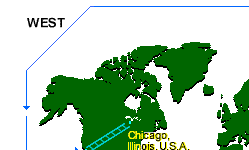 |
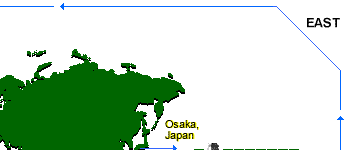 |
 |
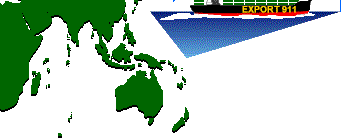 |
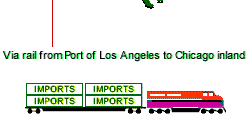 |
Alternately, use the Trans-Siberian landbridge in the Russian Federation or the sea-land carriage or air-land carriage, that is, ocean vessel or airplane reaches the East Coast port (e.g. Port of Nachodka situated in Asia) or area in the Russian Federation and the freight container (or the air cargo transfers to container) connects via Trans-Siberian Railway to the border station in Europe, and then by rail and/or truck to the European countries.
Some exporters from Japan, Hong Kong (China) and Australia use the Trans-Siberian landbridge. Exporters also use the ocean-air service (non-landbridge service) through the Russian Federation, that is, cargo reaches the Russian East Coast port (e.g. Port of Vladivostok situated in Asia) and connect by air to Europe.
The freight rate on export goods is often based on W/M (weight or measure), that is, based on the weight or the volume of cargo (the cube or measurement of cargo). The rate uses the comparative relation between weight and volume of cargo. A cargo that is large in relation to its weight is charged according to its total cube, while a cargo that is heavy in relation to its size is charged according to its gross weight.
In general, light cargo is charged based on measure, while heavy cargo based on weight. Most sea consignments are charged based on measure, while most air consignments are charged based on weight.
The freight cost by weight or measure that will give the carrier the higher revenue is the rate that applies.
The unit of ton being used in the freight cost calculation may differ among carriers. It can be a metric ton (2204.6 lbs. or 1000 kgs.), a short ton (2000 lbs. or 907 kgs.), or a long ton (2240 lbs. or 1016 kgs.). The exporter must verify with the carrier which unit is being used. In practice, the most frequently used is the metric ton.
Units of Weight or
Measure Commonly Used
in the Freight Cost Calculation
| LEGEND: |
||
| MT | = metric ton | |
| kg. | = kilogram | |
| lb. | = pound | |
| CBM | = cubic meter | |
| cu. cms. | = cubic centimeters | |
| cu. ft. | = cubic feet | |
| cu. ins. | = cubic inches | |
| Weight | or | Measure | ||
| Mode
of Transportation |
¡@ | ¡@ | ¡@ | |
| ¡@ | ||||
| Ocean Freight | 1
MT |
1
CBM (35.3 cu. ft.) |
||
| Air Freight | 1 MT(1000 kgs.) | or | 6 CBM (211.8 cu. ft.) | |
| 1 kg. | or | 6000 cu. cms. (366 cu. ins.) | ||
| 1 lb. | or | 166 cu. ins. | ||
| Road and Rail Freight | 1 MT(1000 kgs.) | or | 3.3
CBM |
|
| 1 kg. | or | 3300
cu. cms |
||
| 1 lb. | or | 91.3 cu. ins. | ||
Some freight carriers may use the (long ton) 2240 lbs. (as weight) or 40 cu. ft. (as measure) in the freight cost calculation.
In ocean freight, some freight carriers may use the terms U.S. shipping ton and British shipping ton. One (1) U.S. shipping ton is equivalent to 40 cubic feet, and one (1) British shipping ton is equivalent to 42 cubic feet.
Other units may be used in the inland freight cost calculation. For example, the inland freight could be charged on a per package basis, but within a maximum allowable weight and/or cube per package. Some carriers may rate a product on a weight basis only.
In the case of irregular shaped cargo, the weight or measure applies, where the measure is determined by taking the three widest dimensions that describe the smallest cubic space enclosing the cargo.
In ocean freight, a minimum of usually 2 or 3 CBM (cubic meters) is required. The freight consolidator may specify the minimum requirement in a dollar amount, instead in CBM.
In air freight, a minimum of usually 1 kilogram is required. If a consignment is light and small, it is more economical to ship by air rather than by sea considering the benefits of air freight.
In road and rail freight, the minimum requirements vary widely among carriers.
Case Sample: Weight or Measure Assuming that
an ocean carrier or a freight consolidator offers an exporter
The measure of product DX is large in relation to its weight, that is, the freight cost by measure gives the carrier or the consolidator a higher revenue, thus the exporter pays US$1,836.25. |
||||||||||||||||||||||||||||||||
In times of unstable oil prices, the freight is often quoted with a bunker adjustment factor (BAF) to cover an oil price hike. The BAF, if any, is indicated on the bill of lading. The BAF allows for fluctuations in the cost of oil.